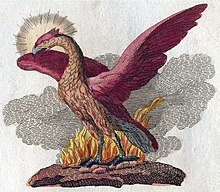
Back Feniks Afrikaans طائر الفينيق Arabic ফিনিক্স (কিংবদন্তি) Assamese Феникс (мифик ҡош) Bashkir Фенікс (міфалогія) Byelorussian Феникс Bulgarian ফিনিক্স পাখি Bengali/Bangla Feniks Breton Feniks BS Fènix (ocell) Catalan
 The phoenix, "unica semper avis" (ever-singular bird), 1583 | |
| Grouping | Mythical creature |
|---|---|
| Folklore | Greek mythology, Egyptian mythology, Phoenician mythology, and Persian mythology |
| Country | Ancient Greece, Ancient Egypt, and Ancient Persia |

The phoenix is an immortal bird that cyclically regenerates or is otherwise born again. While it is part of Greek mythology, it has analogs in many cultures, such as Egyptian and Persian. Associated with the sun, a phoenix obtains new life by rising from the ashes of its predecessor. Some legends say it dies in a show of flames and combustion, while others that it simply dies and decomposes before being born again.[1] In the Motif-Index of Folk-Literature, a tool used by folklorists, the phoenix is classified as motif B32.[2]
The origin of the phoenix has been attributed to Ancient Egypt by Herodotus and later 19th-century scholars, but other scholars think the Egyptian texts may have been influenced by classical folklore. Over time, the phoenix motif spread and gained a variety of new associations; Herodotus, Lucan, Pliny the Elder, Pope Clement I, Lactantius, Ovid, and Isidore of Seville are among those who have contributed to the retelling and transmission of the phoenix motif. Over time, extending beyond its origins, the phoenix could variously "symbolize renewal in general as well as the sun, time, the Empire, metempsychosis, consecration, resurrection, life in the heavenly Paradise, Christ, Mary, virginity, the exceptional man, and certain aspects of Christian life".[3] Some scholars have claimed that the poem De ave phoenice may present the mythological phoenix motif as a symbol of Christ's resurrection.[4]
- ^ Van der Broek 1972, p. 146.
- ^ Thompson. (2001: 581).
- ^ Van der Broek 1972, p. 9.
- ^ White, Carolinne (2000). Early Christian Latin Poets. Routledge. ISBN 978-0415187824.